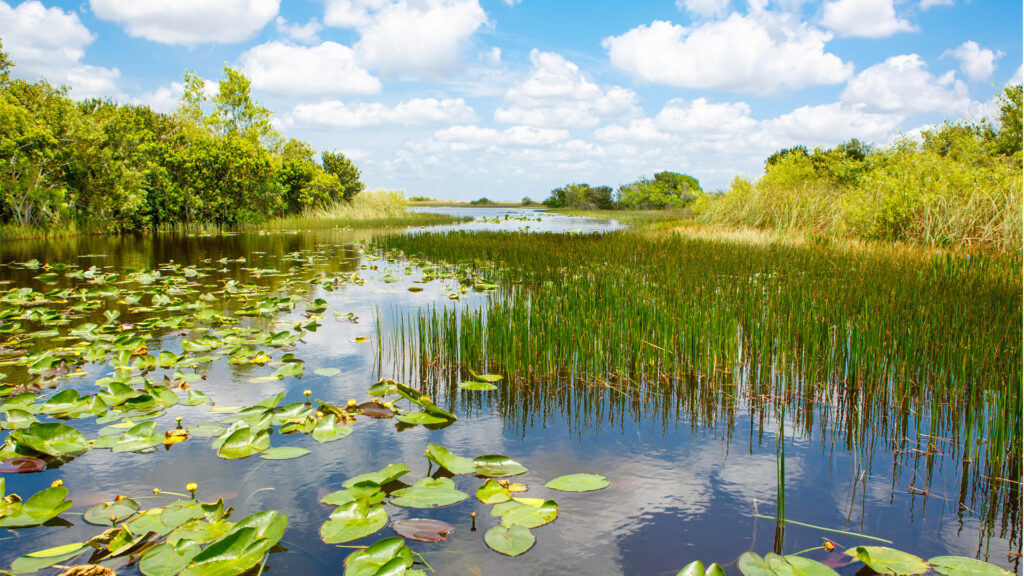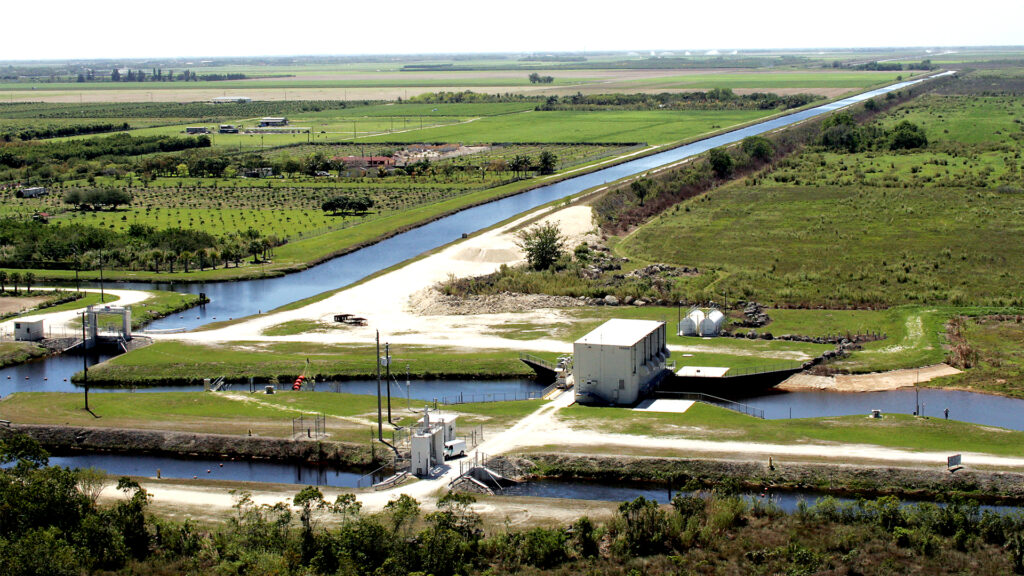This article originally appeared on Inside Climate News, a nonprofit, independent news organization that covers climate, energy and the environment. It is republished with permission. Sign up for their newsletter here.
By Amy Green, Inside Climate News
ORLANDO, Fla. — In 1948, work got underway in the Florida Everglades on a public works project hailed as the nation’s largest, aimed at reigning in once and for all the mighty river of grass that once spanned much of the peninsula.
The effort would take decades to complete and involve some of the most complex water management infrastructure in the world, including some 2,200 miles of canals, 2,100 miles of levees and berms, 84 pump stations and 778 water control structures. The framework would alter the Everglades forever and transform the state: Today it provides flood control and supports the drinking water supply for some 9 million people in central and south Florida. Meanwhile the natural river of grass has been reduced to a remnant of its former self.

By the 1990s, however, a reckoning was at hand. Residents were awakening to a litany of environmental concerns, most notably that draining the Everglades had left Florida with a dwindling drinking water supply for the state’s booming population. The federal and state governments embarked on a restudy of the original public works project, which would lead to a mammoth $21 billion restoration plan for the Everglades that remains among the most ambitious in human history, involving some 68 projects that will take many decades to complete.
Now, climate change is forcing another rethinking: The U.S. Army Corps of Engineers and South Florida Water Management District are poised to begin a new restudy of the Everglades’ historic water management infrastructure aimed at adapting the framework to deal with rising seas, violent storms and a continuing influx of people.
The restudy could mean some alterations to the Everglades restoration plan, said Tim Gysan, resiliency senior project manager in the U.S. Army Corps of Engineers’ Jacksonville District. Back in the 1990s, he notes, climate change wasn’t really something people talked about.
“We’re seeing sea level rise creep up,” Gysan said. “We’re seeing more intense storms. The population increase is massive over the last two to three decades, and more people continue to move here because it’s such a great place to live. But those people moving in, they have to live somewhere. They work somewhere, and that means land use changes.”
Florida has experienced a series of hurricanes and storms in recent months that have drenched the peninsula with unprecedented rains and flooding, raising concerns about whether the infrastructure is up to intensifying climate change impacts like hotter temperatures, rising seas and more damaging hurricanes.
Last September, Hurricane Ian flattened swaths of southwest Florida and left widespread flooding across the state’s interior, causing nearly $113 billion in damage and 156 deaths. The hurricane ranks as the third-costliest in U.S. history, after Katrina in 2005 and Harvey in 2017, according to the National Oceanic and Atmospheric Administration. One preliminary study concluded that climate change increased Ian’s rainfall rates by more than 10%, according to researchers at Stony Brook University and the Lawrence Berkeley National Laboratory.
Hurricane Nicole followed only a few weeks later, further inundating areas Ian had spared. In April, a storm system dropped up to two feet of rain on Fort Lauderdale. The flooding forced the closure of the Fort Lauderdale-Hollywood International Airport and disrupted operations at Port Everglades. Florida ordinarily receives some 50 inches of rain annually.
“Events like that just underscore the need to look at resiliency,” said Steve Davis, chief scientist at the Everglades Foundation. “What that Fort Lauderdale event speaks to is how pressing the need is.”
Taking advantage of a ‘pivot point’ in restoration
The National Academies of Sciences, Engineering and Medicine reiterated that climate change needs more attention last November in its latest federally mandated review of progress on Everglades restoration. The scientists said the government agencies had made little progress when it came to incorporating future precipitation and temperature scenarios in planning their projects and that new, climate-based approaches were urgently needed.
“Inadequate consideration of water availability under future conditions and potential variations in the rate of sea-level rise could cause a project to move forward that is not viable under future climate change,” the scientists wrote.
The scientists noted that Everglades restoration had reached a “pivot point,” with recent record funding pushing several projects toward completion and a few more about to begin. Already the parched river of grass is responding to the work, with healthier water flows and shifts in vegetation throughout the central and western watershed.
A years-long effort to revise the rules for managing Lake Okeechobee, Florida’s largest lake and the liquid heart of the Everglades, is nearly finished. Meanwhile work began in February on perhaps the most contentious and crucial project aimed at restoring the river of grass and its historic flow south: a monumental reservoir south of Lake Okeechobee. At more than 10,000 acres and 23 feet deep, the $3.9 billion reservoir is projected to be complete by 2030.

Everglades restoration involves an array of landscape-scale projects like the reservoir that are jointly designed to revive the river of grass’s historic attributes within the context of today’s explosive growth and development, with a focus on water quality, storage and flow. The watershed begins in central Florida with the headwaters of the Kissimmee River and includes Lake Okeechobee, sawgrass marshes to the south and Florida Bay, at the peninsula’s southernmost tip.
The restudy in the 1990s that led to the massive restoration effort came during a tumultuous time in Florida politics, from a high-stakes 1996 campaign to hold powerful sugar growers responsible for their role in the Everglades’ degradation to the contentious state vote recount in the 2000 presidential race between George W. Bush and Al Gore.
Gore, then vice president, saw opportunity in the critical swing state and had made Everglades restoration a priority for the Clinton administration. As the U.S. Supreme Court mulled the hanging chads on Florida ballots before halting the recount and handing a victory to Bush, then-President Bill Clinton signed Everglades restoration into law.
Congress authorized the new restudy last December as part of the latest Water Resources Development Act. Experts will focus on factors that Everglades restoration has not addressed, especially climate change and flood risk management along the coasts and inland. The effort is expected to get underway in 2024 or 2025 and take six to 10 years to complete.
Gysan said the restudy would probably lead to more construction projects in the Everglades to enlarge the capacity of its water infrastructure.
“So do we need bigger capacity structures? Do we need to improve the canals so they can have more water flowing through them?” he said. “Do we need more storage to hold that water so we’re not just releasing it out to tide and can move it for more beneficial purposes?”
A flood risk study focused on southeast Florida, where climate change impacts are most apparent, is already underway.
Eve Samples, executive director of the group Friends of the Everglades, said that after weather events like Hurricane Ian, there is naturally a temptation to invest in more infrastructure.
But Floridians can’t pump their way out of climate change, Samples said. She argues that planners should adopt a broader outlook and recognize that over time some areas will become uninhabitable.
“There is going to be a lot of pressure to do things that way, to put in more infrastructure, more pumps, more sea walls, because there is a lot of money to be made on building that infrastructure,” she said. “We’ve got to make sure it’s in balance with the natural ecosystem.”
Amy Green covers the environment and climate change from Orlando, Florida. She is a mid-career journalist and author whose extensive reporting on the Everglades is featured in the book “Moving Water,” published by Johns Hopkins University Press, and podcast “Drained,” available wherever you get your podcasts. Amy’s work has been recognized with many awards, including a prestigious Edward R. Murrow Award and Public Media Journalists Association award.
This story was produced in partnership with the Florida Climate Reporting Network, a multi-newsroom initiative founded by the Miami Herald, the South Florida Sun Sentinel, The Palm Beach Post, the Orlando Sentinel, WLRN Public Media and the Tampa Bay Times.



